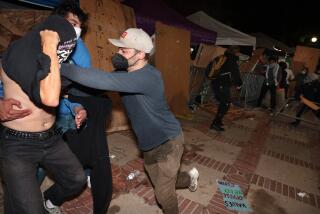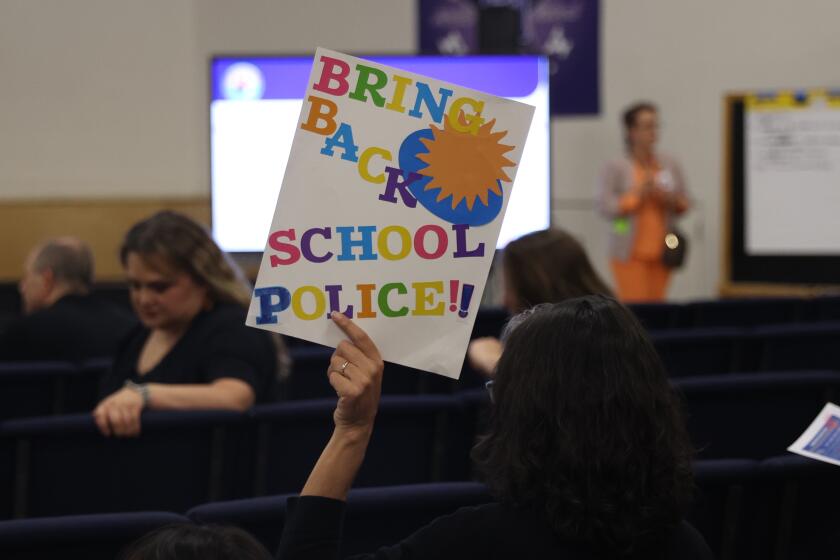School Danger Narrowly Defined
California education officials, pressed by a new federal law to identify “persistently dangerous schools,” have drafted such a restrictive definition of campus crime that many of the state’s largest urban school districts, including Los Angeles, do not have a single campus on the target list.
Like other states, California is required by the No Child Left Behind Act to permit students at crime-ridden schools to transfer to safer sites starting in September.
Under California’s threshold, however, the list will not include a single campus in Los Angeles, Long Beach, Riverside, San Francisco or Fresno, according to those school districts and other sources familiar with the issue. Garden Grove, Santa Ana, San Bernardino, San Diego, Oakland and Sacramento also say they have no persistently dangerous campuses, but their statistics still must be reviewed by the state.
State officials estimate that fewer than 50 of California’s 8,000 schools will meet the definition. But they declined to identify campuses until Wednesday, when the state Board of Education is scheduled to release the list.
Not even Banning High, a 2,800-student Wilmington campus that is part of the Los Angeles Unified School District, would qualify, although it had 28 battery cases, two assaults with a deadly weapon, a robbery and three sex offenses reported during the 2001-02 school year.
The state says that a school is persistently dangerous if at least one of its students has been caught with a firearm in each of the last three years, and if the campus has expelled at least 1% of its students each year for hate crimes, extortion, sexual battery or other violent acts.
But with so few schools expected to be on the list, the policy may need to be revised after it has been in place a year or two, said state Board of Education President Reed Hastings. “I think there is a legitimate debate about what exactly constitutes a persistently dangerous school,” Hastings said Monday.
The standards were designed by a committee mainly made up of local school district leaders, and was adopted last fall by the state board with little discussion. Hastings conceded that his board was preoccupied with other requirements of the No Child Left Behind law at the time and relied heavily on the committee.
Given the lack of federal guidance, committee members said, they struggled to come up with a fair definition that would reflect consistently dangerous activity rather than one very bad incident or simply fistfights and other mischief.
“We labored over this for a very long time and considered all kinds of criteria,” said Karen Hilburn, director of student support services for the Long Beach Unified School District and one of about two dozen school district officials who helped write the definition. “I thought if we are going to be judged by our discipline record, the most consistent is the expulsion standard.”
Randy Hood, an official with the Sacramento City Unified School District who also was on the panel, said one concern among some school districts was that a broader definition of danger might have triggered too many transfers.
Some school safety experts suspect that those logistical concerns, as well as a desire to avoid bad publicity, inspired the rules.
They also say the policy could discourage schools from expelling students to skirt being labeled dangerous. And they note the state definition does not include less dramatic dangers, such as fights and intimidation, which nevertheless make students feel unsafe.
Tim Buresh, L.A. Unified’s chief operating officer, who oversees the district’s school safety programs, said the state should have pressed for a more expansive policy, accounting for troubles that stop short of expulsion.
“This is an index that almost rewards you for turning a blind eye to problems,” Buresh said. “If I’ve got fistfights on playgrounds, that’s an important indication to me that we’ve got to do something.”
Although Los Angeles Unified helped devise the new definition, Buresh was not directly involved in that process.
Ronald Stephens, executive director of the National School Safety Center, a Westlake Village-based organization that serves as a clearinghouse on campus crime issues, said “there is plenty of danger out there” whether or not schools meet the state’s technical definition of dangerous. He said the state should revise the rules under the philosophy of: “Are we doing the best that we can for the safety and educational success of California children?”
“The crime standards are among many elements of the sweeping “No Child Left Behind” education reform law, signed by President Bush in January 2002. The law also allows students to transfer from academically failing schools, requires schools to improve their standardized test scores and demands that all teachers be fully credentialed in two years.
California isn’t the only state about to identify few, if any persistently dangerous schools. Others also have adopted very tight definitions. A final national accounting won’t be ready until the fall. Florida and North Carolina are among those that already have reported no persistently dangerous schools.
Florida’s definition resembles California’s but goes one step further: Those schools with excessive expulsions must survey their students, parents and staff and a majority of the respondents must say that the school is unsafe.
Florida education officials do not think their policy is too limited. Instead, they say the lack of dangerous schools is a reflection of the attention and money that has gone into ensuring safe campuses.
“We’ve really concentrated on relieving the problems that exist at particular schools and districts. As we have found problems in the Florida school system, we have tried to tackle them,” said Frances Marine, a spokeswoman for the state education department
Federal education officials said it is too early to judge the effectiveness of the new state policies on dangerous schools.
But William Modzeleski, director of the Safe and Drug Free Schools Program for the U.S. Department of Education, said the definitions are not an end in themselves.
“There is no one right definition,” he said. “One of the byproducts of this will lead to a debate between the public and state agencies. If there aren’t any persistently dangerous schools, then why not?”
For information about campus crime statewide by school district, see www.cde.ca.gov/spbranch/safety/cssa/cssa.asp.
For statistics about Los Angeles Unified School District campuses, see www.laspd.com.
More to Read
Start your day right
Sign up for Essential California for news, features and recommendations from the L.A. Times and beyond in your inbox six days a week.
You may occasionally receive promotional content from the Los Angeles Times.






